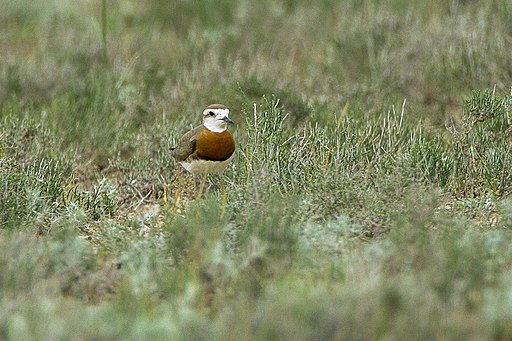Superregnum: Eukaryota
Regnum: Animalia
Subregnum: Eumetazoa
Cladus: Bilateria
Cladus: Nephrozoa
Superphylum: Deuterostomia
Phylum: Chordata
Cladus: Craniata
Subphylum: Vertebrata
Infraphylum: Gnathostomata
Superclassis: Tetrapoda
Cladus: Reptiliomorpha
Cladus: Amniota
Classis: Reptilia
Cladus: Eureptilia
Cladus: Romeriida
Subclassis: Diapsida
Cladus: Sauria
Infraclassis: Archosauromorpha
Cladus: Crurotarsi
Divisio: Archosauria
Subsectio: Ornithodira
Subtaxon: Dinosauromorpha
Cladus: Dinosauria
Ordo: Saurischia
Cladus: Theropoda
Cladus: Neotheropoda
Infraclassis: Aves
Cladus: Euavialae
Cladus: Avebrevicauda
Cladus: Pygostylia
Cladus: Ornithothoraces
Cladus: Euornithes
Cladus: Ornithuromorpha
Cladus: Ornithurae
Cladus: Carinatae
Parvclassis: Neornithes
Cohors: Neognathae
Ordo: Charadriiformes
Subordo: Charadrii
Familia: Charadriidae
Genus: Charadrius
Species: Charadrius asiaticus
Name
Charadrius asiaticus Pallas, 1773
References
Reise durch verschiedene Provinzen des Russischen Reichs 2: [blob:null/b50b2f13-e7f9-d64e-8e4d-597b4ea58d8a 715].
Vernacular names
Afrikaans: Asiatiese strandkiewiet
العربية: زقزاق قزويني
azərbaycanca: Xəzər çovdarçısı
български: Каспийски дъждосвирец
brezhoneg: Nouelig Azia
català: Corriol asiàtic
čeština: Kulík kaspický
Cymraeg: Cwtiad Caspia
dansk: Kaspisk præstekrave
Deutsch: Kaspischer Regenpfeifer
Ελληνικά: Αψινθοσφυριχτής
English: Caspian Plover
Esperanto: Kaspia pluvio
español: Chorlito asiático chico
eesti: Pujutüll
euskara: Kaspiar txirritxo
فارسی: سلیم سینهبلوطی
suomi: Kaspiantylli
français: Pluvier asiatique
עברית: חופמי אסיה
magyar: Sztyeppi lile
հայերեն: Քարադր կասպիական
Bahasa Indonesia: Kèra-kèra
íslenska: Leirlóa
italiano: Corriere asiatico
日本語: ニシオオチドリ
қазақша: Сарысағақ шүрілдегі
한국어: 큰물떼새
lietuvių: Kaspijinis kirlikas
മലയാളം: കാസ്പിയൻ മണൽക്കോഴി
मराठी: कॅस्पिअन चिखल्या
Malti: Birwina ta' l-Asja
Nederlands: Kaspische plevier
norsk: Rødbrystlo
Diné bizaad: Bilį́į́ʼ Ńdeiltihii Dineʼé Bikéyahdę́ę́ʼ tábąądijádíłbáhí
polski: Sieweczka dlugonoga
پنجابی: کیسپین پلوور
português: Borrelho asiatico
русский: Каспийский зуёк
slovenčina: Kulík palinový
slovenščina: Kaspijski deževnik
svenska: Kaspisk pipare
Kiswahili: Kitwitwi Kidari-chekundu
ไทย: นกหัวโตขายาว
Türkçe: Doğu cılıbıtı
українська: Каспійський зуйок
Tiếng Việt: Choi choi á châu
中文: 红胸鸻
The Caspian plover (Charadrius asiaticus) is a wader in the plover family of birds. The genus name Charadrius is a Late Latin word for a yellowish bird mentioned in the fourth-century Vulgate. It derives from Ancient Greek kharadrios a bird found in ravines and river valleys (kharadra, "ravine"). The specific asiaticus is Latin and means "Asian", although in binomials it usually means the type locality was India.[2]
Maasai Mara - Kenya
This plover breeds in western and central Asia and migrates southward to eastern and southern Africa to escape the northern winter.
Description
This plover is slightly larger than ringed plover, and it recalls greater sandplover and lesser sandplover in appearance. It is slimmer and longer-legged than the sandplovers, and has a much stronger white supercilium, and a long thin bill. It also lacks white tail sides and a weak wing bar.
Summer males have grey-brown backs and a white face and belly. The breast is chestnut, bordered black below. Other plumages have a grey-brown breast band, although the summer female may show a hint of chestnut. The call is a sharp chip.
Distribution and habitat
The Caspian plover breeds in western Asia in the area of the Caspian Sea. Its range includes southern Russia, Turkey, Iran, Turkmenistan, Kazakhstan, Uzbekistan and Afghanistan. Its habitat is steppes, desert verges, saltpans and saline soils amongst sparse shrubby vegetation up to an altitude of about 800 m (2,625 ft). After breeding, it migrates to eastern and southern Africa, going as far as the Zambezi River. Its winter quarters are usually dry grassland, coastal dunes, saltmarshes, dry floodplains and sometimes cultivated land.[3] This plover is a very rare vagrant to western Europe. It is also a rare vagrant to Australia.
Biology
Charadrius asiaticus - MHNT
It breeds on open grassland in central Asia, mainly to the north and east of the Caspian Sea. It breeds in loose colonies, with three eggs being laid in a nest on the bare ground or among short vegetation.
It feeds in a similar way to other plovers picking beetles, termites, ants, grasshoppers, small snails and other small prey mainly from the ground. It sometimes eats the seeds of grasses.[3]
Status
File:Caspian Plover.ogvPlay media
Caspian Plover in Saudi Arabia
The Caspian plover has a very wide range. The number of birds may be declining slowly due to degradation of its breeding range, especially in Europe, however the IUCN lists it as being of Least Concern" because it does not consider the rate of decline justifies putting it in a more threatened category.[3]
It is one of the species to which the Agreement on the Conservation of African-Eurasian Migratory Waterbirds (AEWA) applies.
References
BirdLife International (2018). "Charadrius asiaticus". IUCN Red List of Threatened Species. 2018: e.T22693868A131930637. doi:10.2305/IUCN.UK.2018-2.RLTS.T22693868A131930637.en. Retrieved 12 November 2021.
Jobling, James A (2010). The Helm Dictionary of Scientific Bird Names. London: Christopher Helm. pp. 57, 99. ISBN 978-1-4081-2501-4.
"Species factsheet: Charadrius asiaticus". BirdLife International. Retrieved 2013-12-17.
Retrieved from "http://en.wikipedia.org/"
All text is available under the terms of the GNU Free Documentation License


